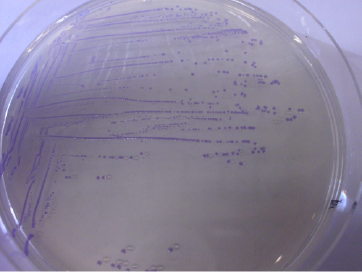Difference between revisions of "Part:BBa K1033206"
| (41 intermediate revisions by 2 users not shown) | |||
| Line 1: | Line 1: | ||
__NOTOC__ | __NOTOC__ | ||
| − | <partinfo> | + | <partinfo>BBa_K1033206 short</partinfo> |
| − | pSBLbC is a shuttle vector | + | The backbone pSBLbC is a shuttle vector that works in E. coli, Lactobacillus, and probably other lactic acid bacteria (LAB) like <i>Lactococcus lactis</i>. It has been used for subcloning in <i>E. coli</i> and to express the chromoprotein [[Part:BBa_K1033209|amilCP]]. Its replicon is known from litterature to replicate in a wide range of gram positive and gram negative species<sup>[[#Footnote 1|[1]]]</sup>. Because E. coli is very easy and fast to work with, and ligations are very hard to transform in Lactobacillus constructs should first be constructed and partly characterised in E. coli. For this we recommend the version with erythromycin resistance ([[Part:BBa_K1033207|BBa_K1033207]]) since it has been successfully transformed to Lactobacillus reuteri 100-23, it also has the advantage of not sharing resistance with the common pSB1C3. |
| − | |||
| − | <!-- | + | https://static.igem.org/mediawiki/2013/1/18/Uppsala2013_Shuttle_Vector_pSBLBC_cp29_amilCP1.png |
| − | === | + | |
| + | <i><b>Fig 1:</b> E. coli D5α carrying pSBLbC with blue chromoprotein [[Part:BBa_K1033282|amilCP, and lactobacillus promotor CP29.]]</i> | ||
| + | |||
| + | === Construction === | ||
| + | It was made by replacing the replicon of the BioBrick compatible plasmid [[Part:BBa_K864001|pSB4C15]] with a broad range replicon from the engineered plasmid pJP059. The replicon is also referred to as pSH71 and is related to pWV01 and the same family of rolling circle replicating plasmids.<sup>[[#Footnote 1|[1]]]</sup> | ||
| + | |||
| + | We have also changed the promotor of the chloramphenicol resistance cassette to one that would initiate transcription effectively in <i>Lactobacillus</i>. We tried several constitutive promotors but got [[Part:BBa_K1033222|CP29]] to work. | ||
| + | |||
| + | <i>See design subpage for more details.</i> | ||
| + | |||
| + | === Results === | ||
| + | We have successfully subcloned small constructs into pSBLbC and used it to transform E. coli D5α. Judging from levels of expression, copy number in E. coli is relatively low<!-- lower than pSB3K3 -->. Despite several attempts we have not managed to transform <i>Lactobacillus reuteri</i> or <i>Lactobacillus plantarum</i>. We strongly suspect the resistance cassette is at fault since positive controls on antibiotic free agar plates have grown, but we have not had enough time to work out a solution. Please see our [[Part:BBa_K1033207|shuttle vector]] with erythromycin resistance, which has met with more success in that area. | ||
| + | |||
| + | === References === | ||
| + | <div id="Footnote 1"></div> <sup>[1]</sup> I. Pérez-Arellano, M. Zúñiga, and G. Pérez-Martínez (2001), [http://www.sciencedirect.com/science/article/pii/S0147619X01915318 Construction of Compatible Wide-Host-Range Shuttle Vectors for Lactic Acid Bacteria and Escherichia coli], Plasmid 46 (2) 106-116. | ||
<!-- --> | <!-- --> | ||
Latest revision as of 20:45, 4 October 2013
Lactobacillus shuttle vector pSBLbC
The backbone pSBLbC is a shuttle vector that works in E. coli, Lactobacillus, and probably other lactic acid bacteria (LAB) like Lactococcus lactis. It has been used for subcloning in E. coli and to express the chromoprotein amilCP. Its replicon is known from litterature to replicate in a wide range of gram positive and gram negative species[1]. Because E. coli is very easy and fast to work with, and ligations are very hard to transform in Lactobacillus constructs should first be constructed and partly characterised in E. coli. For this we recommend the version with erythromycin resistance (BBa_K1033207) since it has been successfully transformed to Lactobacillus reuteri 100-23, it also has the advantage of not sharing resistance with the common pSB1C3.

Fig 1: E. coli D5α carrying pSBLbC with blue chromoprotein amilCP, and lactobacillus promotor CP29.
Construction
It was made by replacing the replicon of the BioBrick compatible plasmid pSB4C15 with a broad range replicon from the engineered plasmid pJP059. The replicon is also referred to as pSH71 and is related to pWV01 and the same family of rolling circle replicating plasmids.[1]
We have also changed the promotor of the chloramphenicol resistance cassette to one that would initiate transcription effectively in Lactobacillus. We tried several constitutive promotors but got CP29 to work.
See design subpage for more details.
Results
We have successfully subcloned small constructs into pSBLbC and used it to transform E. coli D5α. Judging from levels of expression, copy number in E. coli is relatively low. Despite several attempts we have not managed to transform Lactobacillus reuteri or Lactobacillus plantarum. We strongly suspect the resistance cassette is at fault since positive controls on antibiotic free agar plates have grown, but we have not had enough time to work out a solution. Please see our shuttle vector with erythromycin resistance, which has met with more success in that area.
References
[1] I. Pérez-Arellano, M. Zúñiga, and G. Pérez-Martínez (2001), [http://www.sciencedirect.com/science/article/pii/S0147619X01915318 Construction of Compatible Wide-Host-Range Shuttle Vectors for Lactic Acid Bacteria and Escherichia coli], Plasmid 46 (2) 106-116.Sequence and Features
- 10INCOMPATIBLE WITH RFC[10]Illegal prefix found in sequence at 3036
Illegal suffix found in sequence at 1 - 12INCOMPATIBLE WITH RFC[12]Illegal EcoRI site found at 3036
Illegal NheI site found at 1981
Illegal SpeI site found at 2
Illegal PstI site found at 16
Illegal NotI site found at 9
Illegal NotI site found at 3042 - 21INCOMPATIBLE WITH RFC[21]Illegal EcoRI site found at 3036
Illegal BamHI site found at 1960 - 23INCOMPATIBLE WITH RFC[23]Illegal prefix found in sequence at 3036
Illegal suffix found in sequence at 2 - 25INCOMPATIBLE WITH RFC[25]Illegal prefix found in sequence at 3036
Illegal XbaI site found at 3051
Illegal SpeI site found at 2
Illegal PstI site found at 16 - 1000COMPATIBLE WITH RFC[1000]
